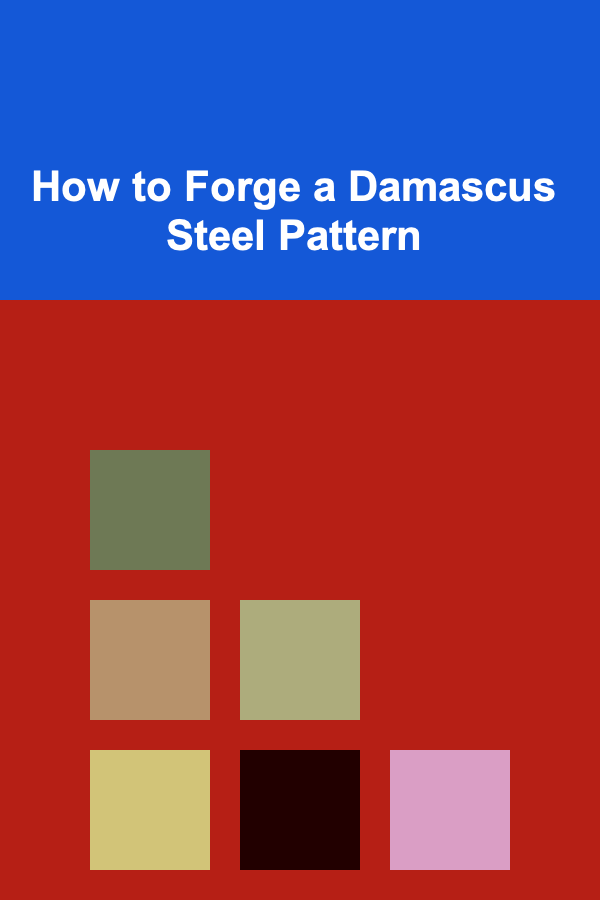
How to Forge a Damascus Steel Pattern
ebook include PDF & Audio bundle (Micro Guide)
$12.99$6.99
Limited Time Offer! Order within the next:

Damascus steel is one of the most legendary materials used in the crafting of blades, known for its beauty, durability, and distinctive patterns. The process of creating Damascus steel has fascinated metalworkers for centuries. Historically, it was used to make blades that were known for their sharpness and strength. Today, modern-day blacksmiths and artisans have revived the art of forging Damascus steel, creating blades that not only perform well but also have a unique and striking appearance.
In this article, we will explore the steps required to forge a Damascus steel pattern, from the selection of materials to the final polishing. We will break down the key stages of the process and provide you with a deep understanding of the techniques involved.
What Is Damascus Steel?
Damascus steel originally referred to the forged steel used to make blades in the Near East, particularly during the medieval period. The term "Damascus steel" is a modern label, and the blades made from this material were known for their patterned surfaces and superior qualities.
Historically, true Damascus steel was made from wootz steel, which was produced in India and Sri Lanka. Wootz steel was high-carbon steel that was smelted in a crucible and cooled slowly. When it was forged into blades, it exhibited a distinct, swirling pattern, which was both functional and decorative. These early Damascus blades were prized for their sharpness and their ability to hold an edge.
In modern times, Damascus steel is created using a technique known as pattern welding, which involves layering and folding different types of steel. The resulting pattern is not only visually stunning but also provides a blend of hardness and toughness in the final blade.
Types of Damascus Steel Patterns
Before forging Damascus steel, it is important to understand the various patterns that can be created. Some of the most common patterns include:
- Random Pattern: As the name suggests, this pattern is irregular and has no specific design. It is created by manipulating the layers of steel in random ways, which results in a highly unique pattern for each blade.
- Raindrop Pattern: This pattern is characterized by small, rounded patterns that resemble raindrops or droplets. This is one of the more distinctive and popular patterns used in Damascus steel blades.
- Twist Pattern: As the name implies, this pattern results from twisting the steel layers. The twist creates a spiraling, corkscrew-like appearance on the surface of the blade.
- Chevron Pattern: This pattern involves folding the layers of steel into a V-shape, creating a chevron-like appearance.
- ** Ladder Pattern**: This pattern is created by stacking the steel layers on top of each other and forging them into a straight line, resulting in a ladder-like appearance when the blade is polished.
Each of these patterns offers its own unique look, and they can be combined or manipulated further to create more intricate designs.
Materials Needed for Forging Damascus Steel
Before you can begin forging your Damascus steel blade, you will need the proper materials and tools. The primary materials are steel billets made from different types of high-carbon and low-carbon steels. The most commonly used steels in Damascus forging include:
- High Carbon Steel: Provides hardness and edge retention to the blade. This is typically the harder steel in the Damascus laminate.
- Low Carbon Steel: Adds flexibility and toughness to the blade, balancing the hardness of the high-carbon steel.
- Stainless Steel: Some modern Damascus steel blades incorporate stainless steel for added corrosion resistance.
Other materials and tools required for forging Damascus steel include:
- Forge: Used to heat the steel billets to the appropriate temperature.
- Hammer and Anvil: Used for shaping and forging the steel.
- Welding Flux: Used to prevent oxidation during the forging process.
- Acid: For etching the pattern once the blade is forged.
- Grinder: For shaping the blade and removing excess material.
- Polishing Tools: Used for finishing the blade after forging.
Steps for Forging a Damascus Steel Pattern
Step 1: Preparing the Steel Billets
The first step in forging Damascus steel is to select and prepare the steel billets. You will need to stack alternating layers of high-carbon and low-carbon steel. The more layers you use, the more intricate the pattern will be. Typically, a beginner may start with around 5 to 10 layers, while more experienced smiths may work with up to 50 or more.
The layers of steel are stacked, and any gaps between the pieces are filled with welding flux to ensure the layers bond during the forging process. Once the stack is prepared, it is tightly clamped together and ready for heating.
Step 2: Heating the Steel
The stack of steel layers is then heated in a forge to a temperature of around 2,200°F (1,200°C). The steel needs to be red-hot for it to be malleable enough to forge. At this temperature, the steel is ready to be welded together. Once the steel reaches the correct temperature, it is removed from the forge and ready for the next step.
Step 3: Forging the Steel
Once the steel is heated, it is placed on an anvil or other suitable surface for forging. Using a hammer, the blacksmith begins to flatten and shape the steel. The goal is to elongate and compress the steel stack, fusing the layers together. The blacksmith will then fold the steel over itself and repeat the process several times to create more layers. Each fold increases the number of layers and helps form the pattern.
For specific patterns like twists or chevrons, the steel is manipulated in different ways. For example, to create a twist pattern, the blacksmith will twist the steel before forging. For a chevron pattern, the layers are manipulated in a V-shape.
Step 4: Welding the Steel Layers
During the forging process, it is important to apply sufficient pressure to ensure that the layers of steel fuse together properly. Welding flux is applied to prevent oxidation and ensure the layers bond. After several passes through the forge and repeated hammering, the stack of steel becomes a solid billet with multiple layers. This billet will be forged into the final shape of the blade.
Step 5: Drawing Out and Shaping the Blade
At this stage, the blacksmith begins to draw out the billet into a blade shape. The steel is heated once again and hammered into the rough shape of the blade. This process is repeated several times, with the blade being forged into its desired dimensions.
Once the blade reaches the rough shape, it is time to refine the shape and edges. A grinder or hand tools are used to clean up the edges and achieve the desired profile. The blade is also tempered during this stage, ensuring it has the right hardness and flexibility.
Step 6: Etching the Pattern
Once the blade is forged and shaped, it is time to reveal the beautiful Damascus pattern. This is done by etching the blade in an acid bath. The acid reacts with the different layers of steel, highlighting the contrast between the high-carbon and low-carbon steel. The acid bath also helps to enhance the pattern, making it more visible on the surface of the blade.
Step 7: Final Polishing
After the acid etching, the blade is polished to remove any oxidation and reveal the full beauty of the pattern. A combination of grinding and polishing tools is used to achieve a mirror finish on the blade. At this point, the blade is ready for final heat treatment and the addition of any handles or other finishing touches.
Conclusion
Forging a Damascus steel pattern is a complex and rewarding process that requires skill, patience, and an understanding of metallurgy. The beauty of Damascus steel lies not only in its striking appearance but also in the way it combines the properties of different types of steel, resulting in a blade that is both sharp and durable. By following the steps outlined in this article, you can create a Damascus steel blade that reflects the rich history and artistry of this ancient craft.
Whether you are a seasoned blacksmith or a beginner looking to learn the craft, forging Damascus steel can be an incredibly rewarding endeavor. The key is practice and persistence, and with time, you will be able to create beautiful and functional blades that showcase the artistry of pattern welding.
Reading More From Our Other Websites
- [Hiking with Kids Tip 101] Trailblazing on a Shoestring: Budget-Friendly Hiking Adventures for Kids
- [Organization Tip 101] How to Track Progress and Goals in Your Wellness Space
- [Home Party Planning 101] How to Keep Your Home Party Guests Entertained
- [Home Family Activity 101] How to Create a Sensory Bin for Toddlers at Home
- [Beachcombing Tip 101] How to Spot and Collect Rare Lepidoptera Larvae During Low‑Tide Beachcombing
- [Home Pet Care 101] How to Make Your Home Comfortable for Senior Pets
- [Needle Felting Tip 101] From Fiber to Finished Piece: A Side-By-Side Comparison of Wet and Needle Felting
- [Organization Tip 101] How to Make a Jewelry Inventory List for Tracking Pieces
- [Personal Investment 101] How to Invest in International Stocks for Broader Exposure
- [Small Business 101] How to Choose the Right Office Supplies for Your Small Business

Building Passive Income through Deep Learning in E-Commerce
Read More
How to Create a Donation Calendar for Year-Round Giving
Read More
How to Organize Craft Supplies Using Clear Containers
Read More
How To Start Stargazing: A Beginner's Guide
Read More
10 Tips for a Job Application Checklist for Executive Roles
Read More
How to Build a Weekly Job Search To-Do List You Can Stick To
Read MoreOther Products

Building Passive Income through Deep Learning in E-Commerce
Read More
How to Create a Donation Calendar for Year-Round Giving
Read More
How to Organize Craft Supplies Using Clear Containers
Read More
How To Start Stargazing: A Beginner's Guide
Read More
10 Tips for a Job Application Checklist for Executive Roles
Read More